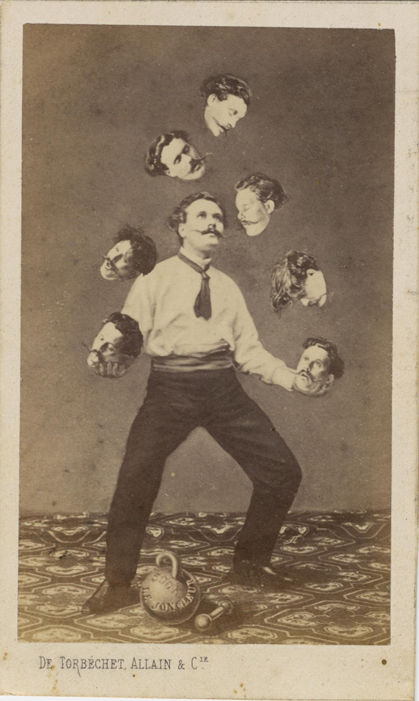
“Faking It: Manipulated Photography Before Photoshop” at the Metropolitan Museum of Art
by Claudia Eve Beauchesne
“Faking It: Manipulated Photography Before Photoshop” (11 October 2012-27 January 2013) traces the history of doctored photographs from 1839, when the medium was introduced, to the 1990s, when graphic editing computer programs became the most popular method of altering photographic images. Although many of the photographs included in the exhibition were modified by juxtaposing or superimposing several exposed negatives to create convincingly realistic images, the exhibition includes few pieces that show signs of physical manipulations. Instead, rows of mid-sized prints line the gallery walls, accompanied by texts and diagrams explaining what modifications were made and how they were achieved.
Unsurprisingly, the works that stand out are the ones in which the hand of the photographer/collagist is discernible. A pocket-sized ambrotype “Reliovo” portrait of a boy, taken by an anonymous photographer in the 1860s, is particularly absorbing. Most of the backdrop surrounding the subject has been scraped off and an image of a rural landscape was inserted behind it, creating the illusion of depth. Another highlight: William Henry Jackson’s 1906 view of the canyon of the Rio de Las Animas Perdidas (River of Lost Souls) in Colorado. Jackson’s original photograph was altered by erasing trees, adding rapids and rock formations from various negatives, painting faraway mountains and then rephotographing the collage to turn it into a picturesque postcard. More than the final print, it’s Jackson’s ingenious photomontage that delights; an extreme, imaginary version of a sublime landscape
Lacking in supporting ephemera and generic in its presentation, “Faking It” seems better suited to the book format – the exhibition catalogue is an engrossing read filled with curator Mia Fineman’s insightful essays. Smaller in scale and conceived as an addendum to “Faking It,” the exhibition “After Photoshop: Manipulated Photography in the Digital Age” features conceptually sophisticated series of photomontages and digitally doctored images presented in dynamic groupings. It should be noted that both exhibitions were sponsored by Adobe, which explains the museum’s decision to divide the history of altered photography into pre- and post-Photoshop. This curatorial choice exposes the way in which corporations can manipulate art institutions and, by extension, art history.
“Faking It” travels to the National Gallery of Art in Washington, DC, 17 February to 5 May 2013, and The Museum of Fine Arts in Houston, Texas, 2 June to 25 August 2013.
This Exhibition Review originally appeared in Issue Three. To learn more about the world of collage, SUBSCRIBE to Kolaj or PURCHASE ISSUE THREE.
INFORMATION
Metropolitan Museum of Art
1000 Fifth Avenue
New York, New York 10028
USA
(212) 535-7710
Hours:
Tuesday-Thursday, 9:30AM-5:30PM
Friday-Saturday, 9:30AM-9PM
Sunday, 9:30AM-5:30PM
Image:
Man Juggling His Own Head
by unidentified artist
albumen silver print from glass negative
circa 1880
Collection of Christophe Goeury. Image courtesy of The Metropolitan Museum of Art, New York.
